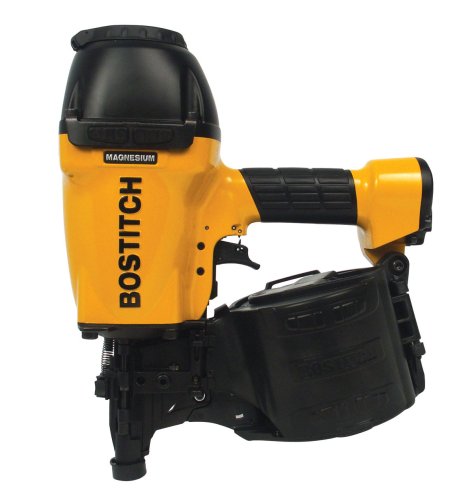Bostitch N89C-1 Coil Framing Nailer Review

Bostitch N89C-1 Coil Framing Nailer Feature
- Pneumatic coil framing nailer with an adjustable exhaust
- Patented push-button adjustable depth guide sets nails to desired depths quickly and easily
- Lightweight magnesium design; aggressive wear guards to protect the tool from damage on abrasive surfaces
- Magazine holds up to 300 nails
- 12-1/4 inches long, 14 inches high; weighs 8.1 pounds; 7-year limited warranty
The N89C-1 has a patented push-button adjustable depth guide to set nails at precisely the desired depths, quickly and conveniently, with minimal downtime between jobs. It also features an adjustable exhaust to direct cast-off air away from your face and your workpiece, for a clearer view of your project.
This model has a driving power of 1,050 in./lbs., and it accepts 15-degree coil framing fasteners from 2 inches to 3-1/2 inches (.099 - .148-inch shank). It operates at 70-120 psi, with a 1/4-inch NPT thread fitting. The N89C-1 has a magazine that holds up to 300 nails. -- Cherie Priest
Applications
Use the N89C-1 for almost any fastening application on the job site or home improvement project. It's perfect for framing, sheathing, siding, fencing, trusses, decks, bridging, pallets and crating, wood, or masonry.
What's in the box
Stanley Bostitch pneumatic coil framing nailer.
Choosing a Pneumatic Nailer
For small household jobs, an old-fashioned hammer is the perfect stand-by. But if you've got a bigger project on your to-do list, then a pneumatic power nailer could be your new best friend. Pneumatic nailers are a great alternative to traditionally powered nailers, because they're capable of providing more power -- and they operate with fewer moving parts, so a pneumatic nailer can take more abuse than its corded or battery-run cousins.
A Word on Air Compressors
All pneumatic tools require a steady supply of controlled, compressed air in order to work properly, and nailers are no exception. Bigger compressors with hardy motors and large tanks generate higher PSI levels and maintain them longer, so you'll probably want a piston-type, two-stage compressor to power your nailer. Smaller or single-stage models are fine for little projects, but if you need a pneumatic nailer, the odds are good that you're looking for some intense PSI and CFM ratings. Sometimes, a pneumatic nailer will come with its own compressor -- or it can be purchased as part of an air tool set.
How Pneumatic Nailers Work
Pneumatic nailers use compressed air power to cock and release the hammer. In order to fire a fastener, a valve opens to let air fill a cylinder -- which has a piston that's driven down hard and fast. This forces the nail out of the gun and into your workpiece. Then the piston recoils, and another nail is loaded.
Important Points to Consider
Check manufacturer's guidelines to find out what pressure (PSI) and volume (CFM) of air will give your pneumatic nailer the best results. Also, keep in mind that any restrictions on the air hose will diminish the tool's performance. Hoses that are very long, contain too much moisture, or are incorrectly sized will reduce air flow. This can prematurely wear out your tool and cause it to perform poorly.
General Features
Most models will feature a rubber nosepiece to prevent scuffing and marring of your workpieces, plus an exhaust system (rear or adjustable) to keep sawdust and debris out of your face and away from your project. Pneumatic nailers usually have an adjustable depth of drive, and depending on the model, they can accommodate nails up to 2-1/2 inches long, in a variety of different gauge sizes. With a powerful enough compressor behind them, they can shoot thousands of nails a day.
Includes High-Power Coil Framing Nailer - N89C


No comments:
Post a Comment